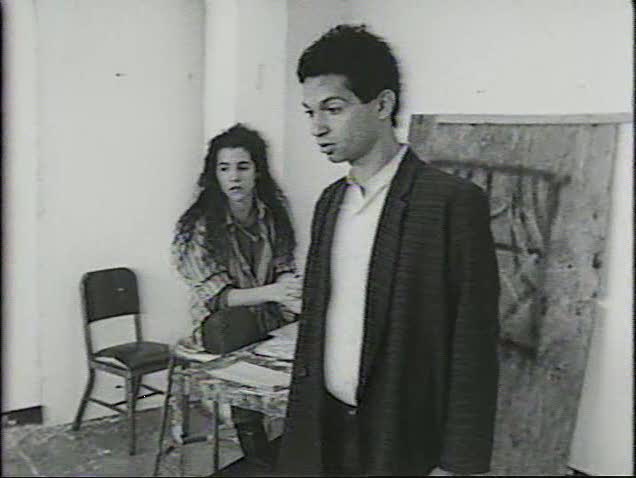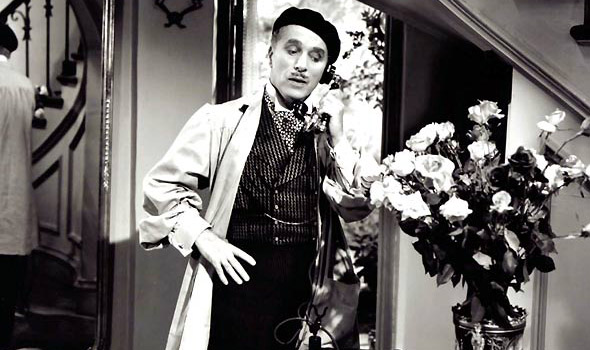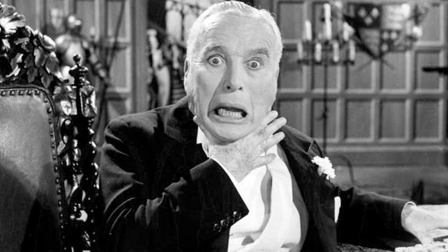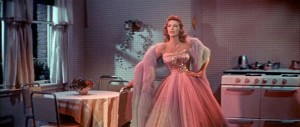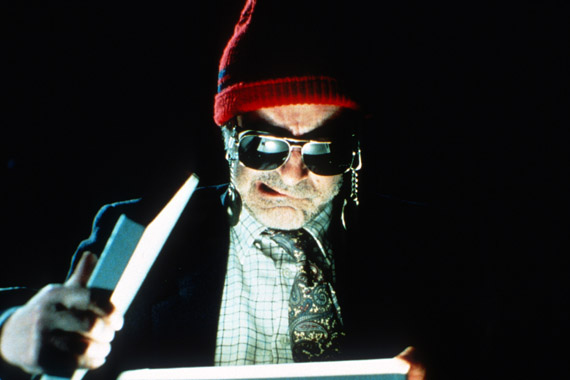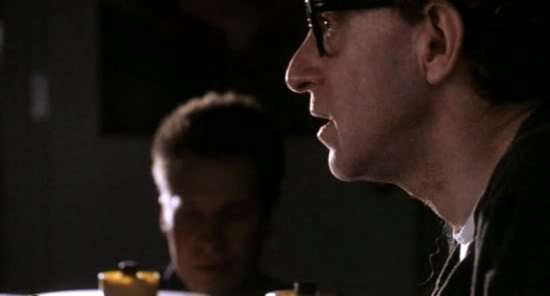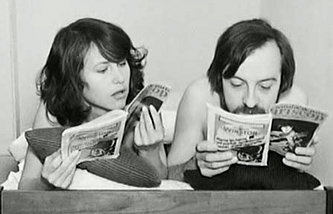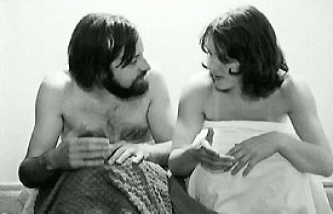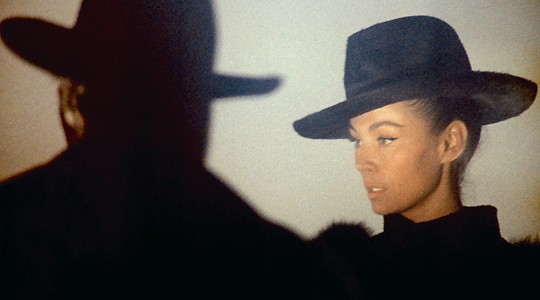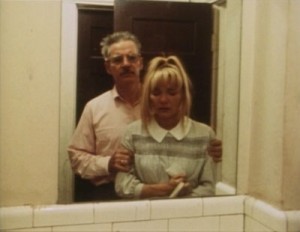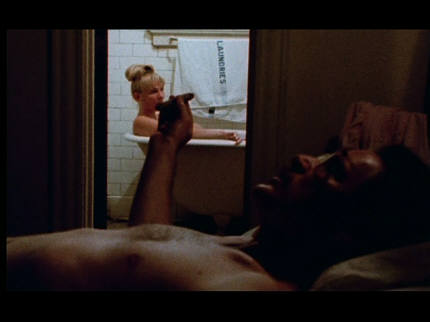Written for Cinema Narcissus, a collection put together for the Rotterdam International Film Festival in early 1992….One of the regular visitors to this site, Barry Scott Moore, has reminded me that in 2013, Ehsan Khoshbakht pointed out to me that Lewis’s first use of the video assist was actually in The Bellboy, his first feature. (He also drew my attention to several typos, now corrected below.) — J.R
The total film-maker is a man who gives of himself through emulsion, which in turn acts as a mirror. What he gives he gets back. — Jerry Lewis
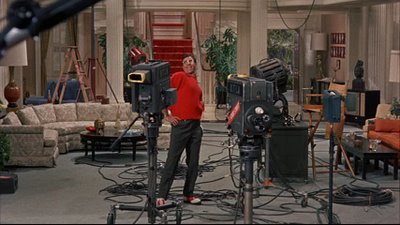
It was Jerry Lewis who first had the idea of installing a video monitor on a soundstage while shooting a picture. The feature in question was THE LADIES MAN (1961), most of which was shot on a single set, a four-storey, open-faced building that stretched across two soundstages on the Paramount lot. The reason for this video monitor? To allow Lewis to see what a particular camera setup looked like at the same time that he was acting in the shot.
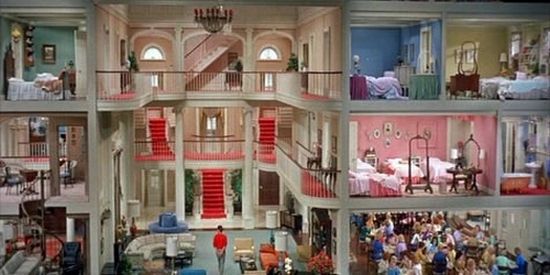
Directing and acting at the same time in comedies is a practice that can be traced back at least as far as the beginning of the 20th century. The earliest example that comes to mind is Georges Melies’s L’HOMME-ORCHESTRE, made in 1900, a double-exposure short in which Melies himself appears as seven different people within the same frame.
The point at which this gesture of self-regard becomes modernist is harder to determine, because it is much more open to interpretation. Does it happen when the director starts to examine himself or herself self-consciously, ironically, or self-critically? Or is the modernist aspect of looking at one’s self already there from the beginning, when Melies replicated himself in front of the camera? When we speak of Chaplin using himself autobiographically, do we trace this process back to his earliest shorts as a director, or do we begin with such complex exercises in self-scrutiny as MONSIEUR VERDOUX, LIMELIGHT, and A KING IN NEW YORK? As a comically demonic self-portrait of neurosis, is Chantal Akerman’s MAN WITH A SUITCASE any more profound than SAUTE MA VILLE!, her very first film?
Minimal in budget as well as in style, form, and content — the entire production is said to have cost a mere $10,000 — A LITTLE STIFF (1991), a black and white 16mm tragicomedy, was shot by two UCLA film students, Caveh Zahedi and Greg Watkins, chiefly in and around their own campus. Both filmmakers play themselves in the movie, as do all the other characters. The slender plot is a literal regurgitation and restaging of events that actually happened, with everyone playing his or her original part. The minimal subject — Caveh Zahedi’s unrequited love for or infatuation with Erin McKim over the space of what appears to be two or three months — is the focus of practically every scene and shot. And part of what makes the film so minimalist is not merely the limited number of settings, camera angles, characters, and dramatic situations, but also the limited number of emotions and behavioral patterns available to these characters.
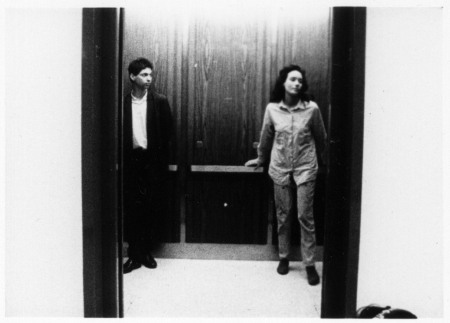
The advantages to be found from this concentration are both comic and analytical, and they never stray from the recognizable and the lifelike. The multiple repetitions that the film employs point to both the monotony of romantic obsession and the monotony of a life-style that simultaneously supports and thwarts such an obsession. As a sort of objective correlative to this syndrome, Caveh’s experimental film-within-the-film, which he shows to Erin at one point, consists of endlessly repeated loops of “falls”: an emaciated concentration camp corpse being dumped into an open grave, a plane nosediving, a prizefighter punching out an opponent, and a silent slapstick comic taking a pratfall, followed by animated drawings of the same actions; all these loops are accompanied by the same musical fragments And the second film-in-the-film of Caveh’s that we see — this time in production as well as in finished form — is nothing less than a staged repetition of the first encounter with Erin in the elevator, another instance of his repetition compulsion that in this case represents a miniature version of A LITTLE STIFF itself. Given this overall obsessiveness, it is hardly surprising that when Caveh receives a “climactic” phone message from Erin asking him to call back, he replays her message twice before he even thinks about complying.
According to legend, when a technician once reported to Chaplin that tracks were visible in one of his shots, he said, “It doesn’t matter — as long as I’m on the screen, people won’t notice.” Even if he didn’t say it, the perception is certainly a correct one. In the famous conclusion of CITY LIGHTS, containing perhaps the most famous close-ups in the history of cinema, the scene cuts between Chaplin in close-up nibbling on a flower stem to reverse angles of Chaplin in medium-shot holding the same flower at least a foot or so lower, against his torso. The final sequence of MODERN TIMES contains a comparable editing “mistake” or mismatch. But no one apart from especially alert film analysts ever notices these flaws. The point of their invisibility is that Chaplin’s power as an actor is the basic fact of his direction, and everything else becomes secondary in importance. (It is worth pointing out that the films of Yasujiro Ozu abound in similar editing “flaws,” but the power of the separate compositions encourage us — much as they undoubtedly encouraged Ozu — to overlook them.) We should therefore conclude either that Chaplin’s physical presence precludes and ultimately overcomes his independent powers as a writer and director or that, at the very least, his writing and directing exist mainly in order to place his physical presence.
Part of what is so complex and exciting about MONSIEUR VERDOUX (1947) is that it shows Chaplin, perhaps for the first time in his career, using his writing and directing to question his acting. Or, if not quite that, at least to put quotation marks on both sides of his charisma, to present a potentially dark meaning to his charm. Known to the world at large as a “ladykiller” because of his amorous offscreen exploits at the time he made VERDOUX, Chaplin dared to link his own appeal as a movie star to both capitalism and murder, and then to examine in some detail what ironies and contradictions arose from these linkages.
Significantly, the idea for VERDOUX was first proposed by another ambiguous screen narcissist, Orson Welles, who wanted to write and direct the picture himself, with Chaplin as star. Accounts differ as to how much of the conception originally stemmed from Welles. Chaplin claimed that Welles never wrote a script while Welles claims that he did (which he called, incidentally, Ladykiller). Both agree, however, that much of the final result came from Chaplin, who updated the plot to encompass World War II to draw parallels between Verdoux’s exploits and the Holocaust.
In A KING IN NEW YORK (1957), Chaplin is working in a more directly autobiographical mode depicting himself literally as a deposed king living in exile, and casting his own son Michael as a “communist” malcontent youth whom the King takes under his wing. Made in England after Chaplin was forcibly barred from re-entering the United States, the film remains one of his most controversial works, carrying such a naked power of embarrassment and assault that one can readily see why many critics and other spectators have recoiled from it. Chaplin himself avoided any mention of it in the text of his autobiography. Most reports refer to it as a shameful debacle and even such an indefatigable Chaplin enthusiast as André Bazin virtually threw in the towel. So far as I can gather, only Roberto Rossellini, seconded by some of his wilder disciples at Cahiers du Cinéma, had the perspicacity in 1957 to call it the film of a free man. Clearly his objections cannot be traced back to any failures of expression: how many films are more expressive than Chaplin’s, this one included? The discomfort, on the contrary, seems to be with the things that are expressed, more candid and personal in their revelations than anything we are ordinarily accustomed to; and without this reading, the film is almost meaningless.
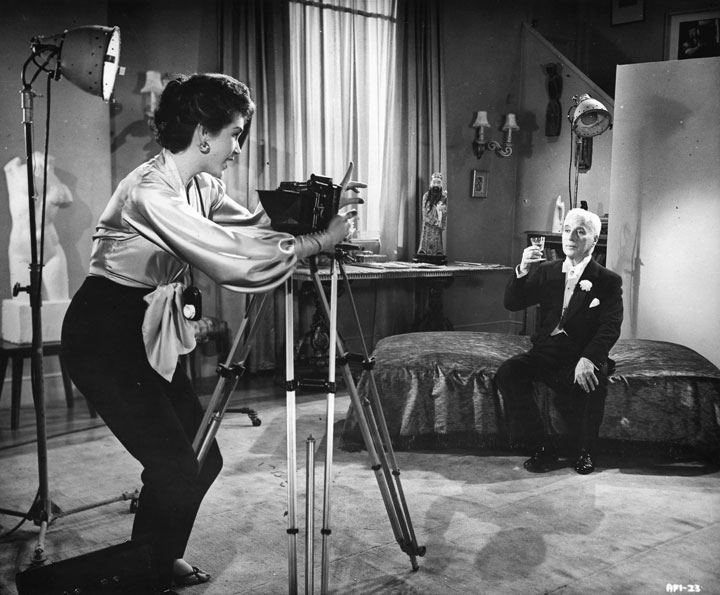
In other words, Chaplin’s letter of spite and sorrow to America asserts personal indignation — perhaps the least palatable form to an audience because it is the most honest, consequently the most apt. In place of generalized invective, we largely get Chaplin’s own experience, which includes his complex and ambivalent implication in the American Dream: the King’s own silliness and randiness in the presence of Dawn Addams, for example. But the horrible taste of the plastic surgery episodes, which immediately derive from this, is not only Chaplin’s transgression but America’s as well; and the charge that much of the film is not very funny should be met with the reply that, as at the end of THE GREAT DICTATOR and throughout much of MONSIEUR VERDOUX, there are times when laughter is beside the point.

As satire, however, the film carries an unusual potency today by focusing on not only all of the American excesses that a 1950s comic director like Frank Tashlin revelled in (THE GIRL CAN’T HELP IT, WILL SUCCESS SPOIL ROCK HUNTER?), but also on some of the insanities that Tashlin left out, the McCarthyite witch hunts in particular. And the free form of expression is such that one can find Godard’s 1960s manner of filming already present in embryo: the King’s visit to the progressive school, for example, anticipates much of the “newsreel” format of a film like MASCULINE FEMININE.
If Picasso’s separate periods as an artist are often defined by separate colors, Jean-Luc Godard’s periods might be linked to different styles and attitudes of self-portraiture. Broadly speaking, from the beginning of BREATHLESS (1960) to the “fin de cinéma” title concluding WEEKEND (1967), it was Godard the film critic and the all-purpose sage. Godard #2, who lasted roughly from May 1968 through the mid-1970s, was a polemical/theoretical rebuke to his predecessor, working principally in 16mm and in collaboration with others. NUMERO DEUX (1975), made in 35mm and video, and JEAN-LUC (1976), made in video, come at the tail end of this period. Godard #3, who began around the same time Godard moved back to his native Switzerland, also marked a return to more commercial considerations (i.e. stars and stories — which #2 had mainly abandoned) and a more concerted move toward placing himself in his work — either literally, as an actor, or autobiographically, as in SAUVE QUI PEUT (LA VIE) or PASSION [see photo below], where actors stand in for him.
Properly speaking, as an actor Godard #3 has A and B versions: the abrasive, crochety, boorish Godard who figures in PRENOM: CARMEN, MEETIN’ WA (his taped 1985 interview with Woody Allen), and KING LEAR [see two photos below]; and the more benign, elder statesman persona who appears in SOIGNE TA DROITE and some of his more recent interviews and TV appearances (such as his dialogue with Marguerite Duras for French television). Just as the theme of prostitution has cropped up frequently in his work — but only when he shoots in 35mm (implying that Godard’s involvements with big-time producers entail a kind of prostitution on his own part) — Godard the curmudgeon seems likelier to emerge when he has to share space with bankable stars. From this vantage point, MEETIN’ WA poses itself as a sort of stand-off confrontation like KING KONG VS. GODZILLA, with each sour comic positioned in a separate corner.
To some extent Luc Moullet can be regarded as a sort of child of Godard, perhaps the last of the Cahiers critics to emerge as a significant actor in his own films. ANATOMIE D’UN RAPPORT (1975), sometimes known in English as FARTHER THAN SEX, is a collaborative film, coscripted and codirected by Antonietta Pizzorno, although I don’t see it as contradicting Moullet’s earlier work. As Jean-Pierre Oudart said of LES CONTREBANDIERES (1967), “Moullet’s film doesn’t speak to us about the world, it is the world that speaks there; and he mechanism of subversion to which it submits itself functions without an auteur.” Yet insofar as it can be called half a Moullet film, I would call it his SCENES FROM A MARRIAGE — that is, a practical, modest work, not a breast-beating declaration of self-important anguish. Pizzorno and Moullet simply made an apparently straightforward movie about their relationship, with the glamor of neither Bergman’s suffering nor their own, just the mundane sorrows and clumsy embarrassments of sexual problems as they’re lived, re-enacted, wrestled with. (Moullet: “I feel like I’m taking an exam.” Pizzorno: “I’ll whisper the answers.”) Christine Herbert plays Pizzorno and Moullet plays himself, but this doesn’t become fully clear until Pizzorno herself appears in the final scene to demand another ending, and Moullet mutters resentfully that “A guy’s gotta make a movie in order to fuck the way he wants.“
It should be added that ANATOMIE D’UN RAPPORT comes from a period in Moullet’s work in which anti-technique is brandished as a kind of substitute for technique — a period also represented by such features as LES CONTREBANDIERES and UNE AVENTURE DE BILLY LE KID (1970). Since then he has honed and refined his comic techniques, both as a director and as a performer, to the point where he has developed a form of proletarian comedy that makes him a director of economy in every sense of the word — of physical, mental, monetary, and existential expenditure — devoted to epics of the everyday that are polemically writ small. While I have not yet seen MA PREMIERE BRASSE, his 1970s documentary about teaching himself how to swim, his hilarious shorts BARRES (1983) and ESSAI D’OUVERTURE (1987) are masterpieces of post-Tati cinema.
Jacques Tati, one should recall, is an especially ambiguous figure in the comedy of Narcissus, because he increasingly regarded his most famous character, Monsieur Hulot, as a commercial necessity rather than as a personal requirement for his comic features. In PLAY TIME he tried to do away with Hulot by multiplying him into infinity, creating a number of “false Hulots” on the theory that everyone was equally funny. He reduced his own role in the plot to that of a catalyst and emissary.
And paradoxically, even a writer-director-actor as theatrical as Orson Welles harbored similar dreams of disappearing into the fabric and texture of his own work, dreams that were fully realized only in THE MAGNIFICENT AMBERSONS (where he still figures as offscreen narrator) and his still unreleased THE OTHER SIDE OF THE WIND, where he makes no visual or vocal appearance at all. His F FOR FAKE (1973) indirectly partakes of the same ambition through a series of elaborate ruses: despite the fact that Welles remains omnipresent throughout the work, both as visual presence and as narrator, he can also be said to be hiding, concealing himself behind a panoply of masks.
Concealment through exposure is a key theme throughout Welles’ work, evident in everything from CITIZEN KANE to TOUCH OF EVIL, from CHIMES AT MIDNIGHT to FILMING OTHELLO. But F FOR FAKE foregrounds this theme in an especially striking way through the constant theme of counterfeiting and fakery. Welles himself expressed some of this paradox in an interview published in the December 9, 1983 issue of the International Herald Tribune: “In F FOR FAKE I said I was a charlatan and didn’t mean it…because I didn’t want to sound superior to [art forger] Elmyr [de Hory], so I emphasized that I was a magician and called it a charlatan, which isn’t the same thing. So I was faking it even then. There wasn’t anything that wasn’t.” A good example of this principle at work in F FOR FAKE is the late scene set in Orly airport in which Oja Kodar becomes Picasso and Welles becomes Kodar’s grandfather, simply by virtue of the fact that the film has persuaded us to accept these actors speaking for these characters.

F FOR FAKE remains one of Welles’s most controversial works insofar as for many spectators, including some Welles enthusiasts, it is not really a “Welles film” at all. There has even, ironically enough, been some confusion regarding the film’s authorship. Simply because Welles refused to include what are generally thought to be “typically Wellesian” shots — a deliberate ploy, one learns from his extended interview with Bill Krohn in Cahiers du Cinéma, and a strategy that can also be found somewhat less systematically in THE IMMORTAL STORY and THE OTHER SIDE OF THE WIND — viewers who insist that they know who Welles is better than Welles does himself wind up feeling that they’ve been had. The legend of Welles has always had much more potency for many people than the reality, and in more ways than one F FOR FAKE appears to have been both inspired by this paradox and structured around it.
Properly speaking, the Cinema of Narcissus permits all sorts of variations and combinations when it comes to self-scrutiny: self-aggrandizement, autocritique, dialectical inquiry, playful self-representation (as in parts of Jan Oxenberg’s THANK YOU AND GOOD NIGHT), self-exploration through displacement (as in Barbara Loden’s 1971 WANDA [see two photos above]), stylistic reinforcement, concealment, disguise, confession. If, as Jerry Lewis points out, the emulsion functions as a mirror for the filmmaker, there are many ways that it can and should function as a mirror for the spectator as well.



